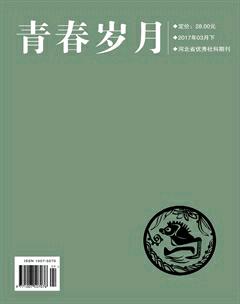The Representative of Chinese culture
Abstract:Chinese culture can be traced as a long history and it contains great significance. The culture of Carapace-bone-script is always shining its glorious radiance. This paper first introduces the original history and the connotation of its culture; then, it illustrates its development of sound, form and meaning; at last, it concludes how the carapace-bone-script influences us.
Key words:carapace-bone-script;Chinese culture;character
In Chinese history, carapace-bone-script is the earliest character. Based on the data of characters in Shang dynasty, there are pottery-script, jade-script, carapace-bone-script and bronze-script. However, carapace-bone-script of late Shang dynasty occupies the largest number. In addition, other characters of Shang dynasty belong to a same system with carapace-bone-script. Thus, carapace-bone-script is the representative character in Shang dynasty. In the history of Chinese characters, carapace-bone-script had been used for divining and recording. It was also the character used in reality at that time. Carapace-bone-script is the shortened form for the character of carapace-bone-script. This abbreviation comes from a series of names, such as “tortoise-shell-script”, “divining-character” of Yin dynasty ruins and so on.
Carapace-bone-script is the earliest character and the most comprehensive character among all the ancient Chinese characters that have been found. Carapace-bone-script mostly refers to the script of Yin dynasty ruins, thus it is also named as “Yin dynasty ruins character” or “Yin dynasty wedge”, which has ever been sculptured on carapaces of tortoises or bones of animals. In late 19th century, this kind of character was discovered at the ruins of Yin dynasty, namely todays city of Anyang, which is located in Henan province. Later then, the relevant researchers found that it carried on the skills of pottery-script coinage and served for the divining and recording of royal family in late Shang dynasty.
Carapace-bone-script is not only the earliest character of Chinese, but also one of the four ancient scripts all over the world. Its coinage includes pictograph, ideograph, phonogram , zhuanzhu and loan character. Carapace-bone-script of Yin dynasty ruins is the recording of divining which owns long history in China. Whats more, the sovereign and nobleman of Shang dynasty, even divined for whatever issues. Thus, divining became the key part in peoples daily life in Shang dynasty. The formation of carapace-bone-script has a system of strict rules from selecting, storage, repairing, sculpturing of carapace-bone, to the ways and procedure of divining, to the grammar, and rhetoric of divining language.
The content of divining includes fete, astronomy, harvest, war etc., and even involves hunting, illness, dream, gestation etc.. The discovery of Yin dynasty carapace-bone-script is the proof of the perished divining principles of Shang dynasty, and provides important resources for historical research. Up to now, there have been about 150 thousand pieces of carapace-bones where record 4,500 or so characters.
The form of carapace-bone-script has great significance in Chinese history. According to the 1,500 single characters that have been recognized, carapace-bone-script has basically formed as modern characters. Its calligraphy development experienced bronze-script, seal characters, and so on. However, the characters that characterized by form, phonetics, and meaning, as well as the basic grammar remained, which has become the squared form still used by one quarter of people in the world. Its formation did a great influence for the ways of Chinese thoughts and the value of Chinese aesthetics, and laid a foundation for the production and development of Chinese calligraphy art. Carapace-bone-script yet became the only one remained to today among the four scripts in the world. Nowadays characters that evolved from carapace-bone-script play an important role in spreading Chinese culture and promoting the great united China.
For the structure of characters, carapace-bone-script has contained the characteristics of “the six categories of Chinese characters”, namely pictograph, ideograph, loan, phonogram and zhuanzhu. These six categories are the principle of Chinese character creation. However, carapace-bone-script mostly created according to pictograph, ideograph, echoism and loan. These four means will be discussed one by one in the following part.
Pictograph is formed as picturing the concrete things with ellipsis or simplifying. For example, the characters like “狗”“猫”appears as the figures of that animals body; characters like “日”“月”come from astronomy. Ideograph refers to character whose meaning comes from its structure. For example, character “即” is composed by the tableware“艮” on the left and the pictograph figure “人”。Thus, a person approaches the tableware to eat, namely means “就”,and “即” has the meaning of “就”。Also “既”, the pictograph person on the right turn its head to the other side which means that this person has had the meal, thus, character “既” has the meaning of “已经”.
Loan characters refer to characters which borrow the sounds of pictograph to express the same sounds of other things. However, loan characters have lost the meaning of primary form but have become the replaced characters which have the same sounds. For example, character “羽” borrows from “翌” (meaning tomorrow) which remains form and sound of “翌” but expresses a new meaning.
Carapace-bone-script had aroused great reflection in academic fields after it was discovered. For monopolizing money, the antique traders kept secret for the real produced place. Until 1908, the scholar Luo Zhenyu first visited and knew carapace-bone-script came from a village around Xiaotun in Anyang, Henan province.
After Luo Zhenyu, many famous scholars such as Wang Guowei, Guo Moruo etc. have done efficient research on carapace-bone-script and they form a special knowledge—school of carapace-bone-script.
As a whole, the emerging of carapace-bone-script has great historical significance. The discovery of carapace-bone-script is a lamp lightening Chinese culture. Up to now, researches on culture of carapace-bone-script have yet not completed. Large unknown fields about it remain to be exploited. We should keep a developing horizon on the knowledge of carapace-bone-script.
【作者简介】
李冯茹(1993—),女,汉族,河南省安阳市人,天津外國语大学英语语言学硕士在读。

